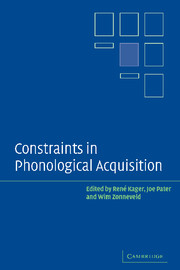Book contents
- Frontmatter
- Contents
- List of contributors
- Abbreviations
- Preface
- 1 Introduction: constraints in phonological acquisition
- 2 Saving the baby: making sure that old data survive new theories
- 3 Markedness and faithfulness constraints in child phonology
- 4 Input elaboration, head faithfulness, and evidence for representation in the acquisition of left-edge clusters in West Germanic
- 5 Phonological acquisition in Optimality Theory: the early stages
- 6 Syllable types in cross-linguistic and developmental grammars
- 7 Bridging the gap between receptive and productive development with minimally violable constraints
- 8 Learning phonotactic distributions
- 9 Emergence of Universal Grammar in foreign word adaptations
- 10 The initial and final states: theoretical implications and experimental explorations of Richness of the Base
- 11 Child word stress competence: an experimental approach
- Index of subjects
- Index of names
2 - Saving the baby: making sure that old data survive new theories
Published online by Cambridge University Press: 22 September 2009
- Frontmatter
- Contents
- List of contributors
- Abbreviations
- Preface
- 1 Introduction: constraints in phonological acquisition
- 2 Saving the baby: making sure that old data survive new theories
- 3 Markedness and faithfulness constraints in child phonology
- 4 Input elaboration, head faithfulness, and evidence for representation in the acquisition of left-edge clusters in West Germanic
- 5 Phonological acquisition in Optimality Theory: the early stages
- 6 Syllable types in cross-linguistic and developmental grammars
- 7 Bridging the gap between receptive and productive development with minimally violable constraints
- 8 Learning phonotactic distributions
- 9 Emergence of Universal Grammar in foreign word adaptations
- 10 The initial and final states: theoretical implications and experimental explorations of Richness of the Base
- 11 Child word stress competence: an experimental approach
- Index of subjects
- Index of names
Summary
Introduction
At the peak of the influence of Generative Phonology, Charles Ferguson and Carol Farwell of the Stanford Child Phonology Project published a troubling observation (Ferguson and Farwell 1975), based on longitudinal data: they showed that the construct of ‘phoneme’ did not (indeed, does not) do justice to the patterns of variation in some young children's production of speech sounds (see also Menyuk et al. 1986). But data which, like these, do not fit any recognisable theory are like a strange tool that comes without instructions, or an unfamiliar spice for which one has no recipe. They stay in a box, untouched. Perhaps they are retrieved from storage when some use for them comes along; but more likely, they are only noticed lurking there after something similar has been rediscovered somewhere else, at a time and place where the odd item can at last be assimilated (cf. the rediscovery of Mendelian heredity).
Once we do have a new beautiful theory that can handle data which were previously intractable, we tend to go on a binge: we try to show that it can do almost everything. That is good – we have to check out its power. But we also tend to shove all the data that do not fit the new theory into that storage box, whether or not they were well handled by a previous approach.
- Type
- Chapter
- Information
- Constraints in Phonological Acquisition , pp. 54 - 72Publisher: Cambridge University PressPrint publication year: 2004
- 1
- Cited by



